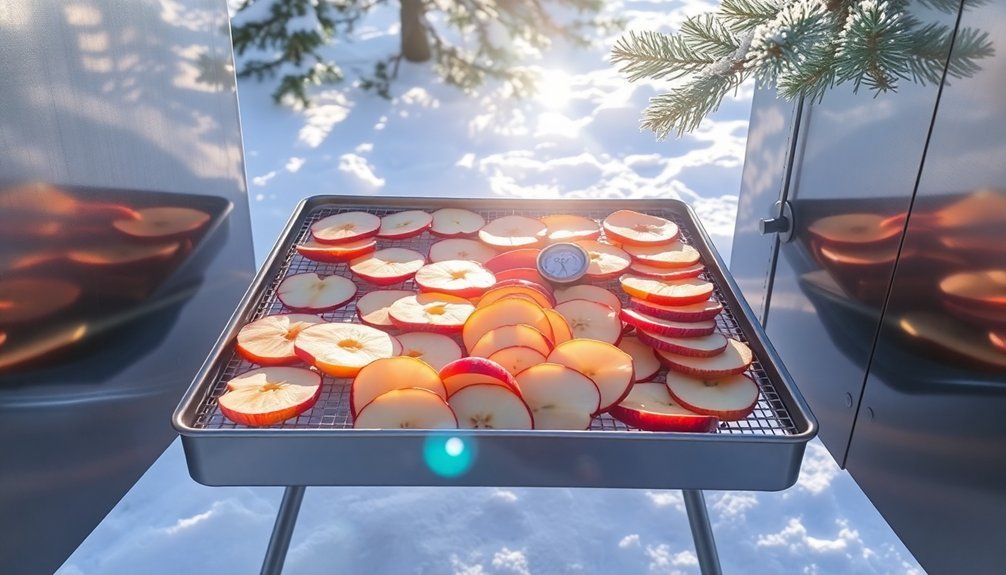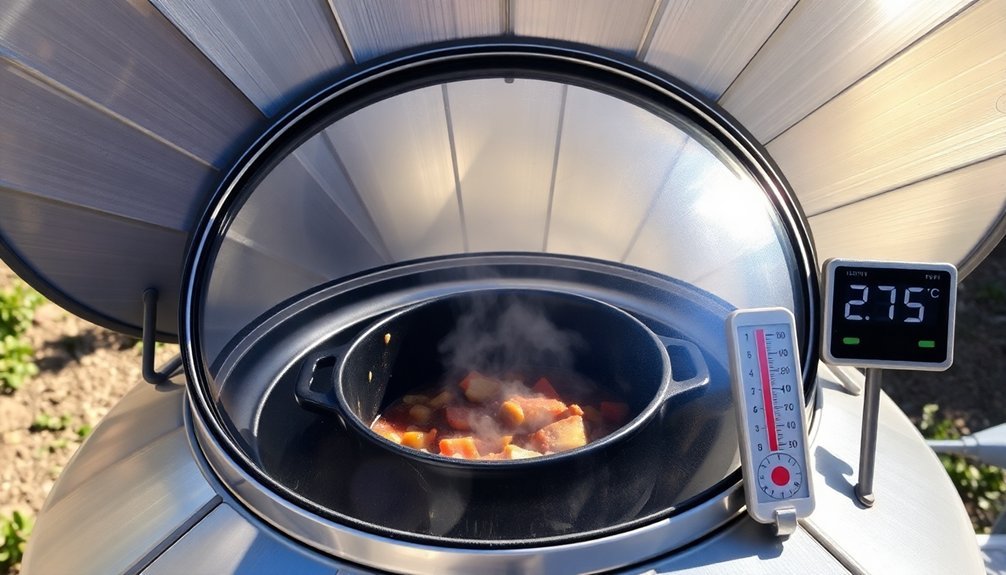You'll need several key adaptations to make winter solar food dehydration work effectively. Start by upgrading your dryer with double-paned glazing, dark heat-absorbing materials, and proper insulation to combat cold temperatures. Position your dehydrator at a steeper 60-70 degree angle facing south, and track the sun's path throughout shorter winter days. Choose high-moisture foods like watermelon, berries, and tomatoes, but expect longer drying times of 4-5 days compared to summer's 2-3 days. Monitor weather forecasts carefully and maintain temperatures between 120-140°F. These fundamentals just scratch the surface of winter dehydration success.
Cold Weather Equipment Adaptations

While winter solar dehydration presents unique challenges, you can successfully preserve food by adapting your equipment for cold weather operation.
Start by upgrading your dryer's glazing to double or triple panes, which will greatly reduce heat loss and maximize solar energy retention during colder months.
You'll need to enhance your solar collector's heat absorption capabilities by incorporating dark-colored materials. Position your dehydrator for optimal southern exposure for maximum sunlight capture.
Paint your galvanized steel lath flat black and add reflective elements like aluminum foil or mirrors to capture additional solar energy. These modifications help compensate for reduced winter sunlight intensity.
Make certain you've sealed all seams and corners with clear silicone caulk to create an airtight environment.
This prevents precious warm air from escaping and cold air from infiltrating the drying chamber. Pay special attention to insulation around the entire unit, particularly in areas where heat loss commonly occurs.
For improved performance, you'll want to install a forced convection system using PV-powered fans.
This guarantees consistent airflow even during overcast winter days. Position your vents strategically to maintain ideal temperature control while preventing moisture buildup that could compromise your food's drying process.
Winter Sun Positioning Tips
To maximize your winter solar dehydration efforts, you'll need to carefully track the sun's daily path across your property and adjust your dehydrator's position accordingly.
Make sure you're taking full advantage of southern exposure, where the winter sun spends most of its time in northern latitudes.
You can boost your solar collection by strategically positioning reflectors to redirect additional sunlight onto your dehydrator's surface, effectively increasing the amount of solar energy available for food preservation. The OMY® dehydrator comes with a mirror reflector specifically designed for this purpose.
Track Sun's Daily Path
Successfully tracking the sun's path becomes essential for winter solar dehydration, when daylight hours are shorter and the sun sits lower in the sky.
You'll need to adjust your dehydrator's orientation throughout the day to maximize exposure to the limited sunlight available.
Start by positioning your dehydrator at a steeper angle that matches the winter sun's lower path. You can use adjustable mounts to easily modify the angle as the sun moves across the sky.
Watch your dehydrator's shadow – it'll tell you if you're capturing maximum sunlight. When the shadow is at its smallest, you've achieved ideal positioning.
Monitor the sun's movement every few hours and reposition your dehydrator accordingly. The process combines heat and air flow to effectively remove moisture from your foods.
Consider marking ideal positions for morning, noon, and afternoon to make daily adjustments quicker.
You'll want to place your dehydrator where it won't be shaded by buildings, trees, or other obstacles during any part of the day.
Using fixed reference points on your property can help you consistently align your dehydrator with the sun's changing position.
For maximum efficiency, you should also regularly clean any reflective surfaces you're using to enhance light capture.
Maximize Southern Exposure
Southern exposure mastery stands as the cornerstone of winter solar dehydration. You'll need to position your solar dryer facing directly south to capture the maximum amount of sunlight during shorter winter days.
Choose a location that's completely free from shade during peak sun hours, as even partial shade can greatly reduce your dryer's efficiency.
To optimize your setup, place your dryer on level ground and tilt the collector surface toward the sun. You'll want to use heat-absorbing materials like black metal or cloth to enhance the thermal efficiency of your system.
Install a glazing system to trap heat and shield your food from cold winter winds, while ensuring the drying chamber remains well-insulated to maintain stable temperatures.
For best results, mount your dryer on an elevated platform to prevent ground frost from affecting the bottom.
You'll need to monitor internal temperatures closely, aiming for 120-140 degrees Fahrenheit, and adjust the collector's tilt angle as needed throughout the winter season.
Remember to incorporate proper ventilation to maintain consistent airflow while preventing heat loss through careful design of your inlet and outlet vents.
Angle Reflectors for Light
Building on proper southern exposure, mastering reflector angles becomes your next step in winter solar dehydration. You'll need to position your collectors at a steeper angle during winter months since the sun travels lower across the sky. For locations like Louisville, KY, you'll want to set your angle between 60-70 degrees to enhance winter sun capture.
While external reflectors can boost solar energy collection, they're often more trouble than they're worth due to constant adjustments. Instead, focus on these proven approaches for ideal winter performance:
- Adjust your collector's angle to match the sun's position at solar noon, roughly a month from the winter solstice.
- Utilize internal reflection through proper glazing and black absorber sheets to convert UV and visible light into heat.
- Install diagonal layers of black metal screens inside your dehydrator to absorb and distribute heat evenly.
- Maintain temperatures between 110-140 degrees through proper insulation and vent control.
Your goal isn't to expose food directly to sunlight but rather to create solar-heated air that efficiently dries while preserving nutrients.
Well-positioned glazing will both trap heat and protect against heat-stealing winter winds.
Insulation and Heat Retention

You'll need to construct your solar dehydrator with double walls to create an insulating air pocket that traps heat effectively.
Inside the box, add heat-absorbing materials like black-painted surfaces or metal sheets to maximize the winter sun's thermal energy.
The combination of double-wall construction and heat-absorbing materials helps maintain ideal drying temperatures even during cold weather, making your winter dehydration projects successful.
Double-Wall Box Construction
Mastering the double-wall construction of a solar food dehydrator is essential for successful winter dehydration. You'll need to create a thermal buffer between two walls, which greatly enhances heat retention and maintains consistent temperatures inside your dehydrator.
Using materials like fiberglass-reinforced polyester (FRP) or Sun-Lite HP for glazing will help trap solar heat effectively while ensuring durability.
To improve your double-wall construction, consider these critical elements:
- Install an open bottom end for proper air intake, allowing natural convection to move heated air upward through your system.
- Create diagonal layers of metal screen inside the box to promote efficient air circulation and even heat distribution.
- Use a heavy, well-sealed door (like a repurposed patio door) to prevent heat escape.
- Position your solar collector at the ideal angle using solar calculators for maximum sun exposure.
You can enhance your double-wall design by incorporating a black box pre-heater for incoming air and adding wheels for mobility.
While a second glazing layer might increase internal temperatures, you'll need to weigh this benefit against the additional cost and complexity of installation.
Heat-Absorbing Materials Inside
Three essential heat-absorbing components work together to maximize your solar dehydrator's efficiency: matte black aluminum plates, specialized coatings, and strategic insulation.
Your absorber plates should be matte black aluminum with fins to increase surface area and heat transfer. You'll get the best results by incorporating both horizontal and vertical fin arrangements, as these affect airflow patterns.
For even better performance, consider ribbed fins with variable arcs, which can boost temperatures by up to 63.7°C.
To enhance heat absorption, you'll want to apply specialized coatings containing silicon nanoparticles. These innovative coatings can help you achieve temperatures up to 98.5°C when mixed at 15% concentration.
The combination of nanoparticles and composite materials creates an ideal surface for heat transfer and improved efficiency.
Don't forget proper insulation – it's vital for maintaining consistent temperatures between 60-65°C. Use plywood or wood for your dryer box construction, focusing on insulating the back of the drying cabinet.
This strategic insulation reduces heat loss and helps maintain steady temperatures, which is essential for effective winter dehydration.
With these components working together, you can achieve thermal efficiency rates of up to 65%.
Winter Prep Time Requirements
During winter months, successful solar food dehydration requires greatly more preparation time and attention than in warmer seasons.
You'll need to plan for extended drying periods of four to five days or more, compared to the typical two to three days in summer. This means you'll have to carefully coordinate your dehydration schedule with weather forecasts and available daylight hours.
To guarantee your winter dehydration efforts succeed, you'll need to incorporate these essential prep steps:
- Pre-check weather forecasts for consecutive sunny days, as cloudy or rainy conditions will interrupt the drying process.
- Set up a temporary indoor storage system for partially dried foods during evening hours.
- Clean and maintain your solar dryer more frequently to prevent moisture buildup.
- Plan for rotating trays multiple times throughout the day to achieve even drying.
You'll also need to schedule regular monitoring intervals to check food moisture levels and adjust drying conditions.
Since winter humidity and cooler temperatures greatly slow the process, you must be prepared to move foods to refrigerated storage if weather conditions suddenly change.
This increased hands-on time guarantees your dehydrated foods reach proper dryness without developing mold or spoilage.
Optimal Cold Season Foods

While careful preparation is key for winter dehydrating, selecting the right foods makes all the difference in your success rate. You'll want to focus on water-rich fruits and vegetables that naturally contain ideal moisture levels for effective dehydration.
| Food Type | Water Content | Key Benefits |
|---|---|---|
| Fruits | 90-92% | High in natural sugars, preserves well |
| Vegetables | 89-96% | Rich in nutrients, versatile use |
| Dairy/Others | 85-89% | Protein-rich, good texture retention |
Your best choices include water-dense fruits like watermelon, cantaloupe, and berries, which retain their flavors well during the dehydration process. For vegetables, you'll get excellent results with tomatoes, bell peppers, and leafy greens like spinach, which are packed with nutrients and have high water content. These foods typically maintain their nutritional value even after dehydration.
Don't overlook protein-rich options like low-fat yogurt and eggs, which can be successfully dehydrated for winter storage. When you're selecting foods for dehydration, prioritize those with water content above 85%, as they'll provide the most consistent results in winter conditions while preserving essential nutrients and flavors.
Managing Winter Moisture Levels
Successful winter dehydration requires precise moisture management throughout the entire process. You'll need to monitor humidity levels carefully while implementing proper design elements to maintain ideal drying conditions. Using a hygrometer helps you track moisture content, guaranteeing it stays below 60% for shelf stability.
The combination of black-painted surfaces and transparent covers creates an effective solar heat trap, while proper ventilation prevents excess moisture buildup.
To maximize your winter dehydration success, follow these essential steps:
- Pretreat your foods with appropriate dips (ascorbic acid, salt water, or fruit juice) to maintain quality and prevent browning.
- Install air vents and consider a PVT system for enhanced moisture removal during the dehydration process.
- Slice foods uniformly and remove them during adverse weather conditions to prevent rehydration.
- Store finished products in airtight containers, properly labeled with dates.
You'll want to adjust your dehydrator's angle based on seasonal conditions and maintain detailed records of moisture levels to enhance future sessions.
Regular cleaning and sanitization of all equipment and surfaces guarantees food safety throughout the process. Remember to perform frequent progress checks to avoid over or under-drying your foods.
Weather Pattern Planning

Smart weather pattern planning lies at the heart of winter solar dehydration. You'll need to closely monitor weather forecasts and identify consistent sunny day stretches to maximize your dehydration efforts. Even in winter, you can find periods of clear skies that'll provide the necessary conditions for effective drying.
To optimize your winter dehydrating schedule, you'll want to start early on sunny days to capture maximum daylight hours. Position your dehydrator in locations that naturally reflect heat, such as concrete driveways or south-facing walls.
You'll need to be ready to bring your trays inside if unexpected weather changes occur, particularly when temperatures drop or clouds move in.
When you're planning your drying sessions, factor in longer processing times than you'd need in summer. You can compensate for winter's shorter days by using indirect solar methods that maintain more consistent temperatures.
If you're working with a variable forecast, prepare to supplement solar drying with indoor heating methods. Remember to adjust your ventilation system to prevent moisture buildup, which becomes especially critical during winter's temperature fluctuations.
Frequently Asked Questions
How Does Altitude Affect Winter Solar Dehydration Times?
You'll find that higher altitudes increase drying times due to colder temperatures, but dry air and intense UV radiation can offset this. You'll need larger solar collectors and better insulation to maintain efficiency.
Can Snow Reflection Be Used to Enhance the Drying Process?
Yes, you can use snow's high reflective properties to enhance your solar dehydration. By positioning your dehydrator to capture reflected sunlight from snow surfaces, you'll increase the available solar energy for drying your food.
What Backup Power Options Work Best During Cloudy Winter Days?
You'll get the best backup power from whole-house solar generators with large battery storage like EcoFlow Delta Pro. They'll keep your dehydrator running through cloudy days and seamlessly switch power when needed.
Do Different Metals for Tray Construction Affect Winter Drying Efficiency?
Yes, your tray metal choice impacts winter drying efficiency. You'll get better results with aluminum's superior heat conductivity, while stainless steel retains heat longer but conducts more slowly during cold conditions.
How Do Winter Air Pollutants Impact Food Safety During Dehydration?
You'll need to protect your drying foods from winter pollutants like road salt, vehicle emissions, and wood smoke. These contaminants can settle on food surfaces, compromising safety unless you're using proper filters and covers.
In Summary
You'll find winter solar food dehydration success by implementing proper equipment modifications, strategic sun placement, and effective insulation methods. Keep track of weather patterns and choose cold-hardy foods that dry well in lower temperatures. Remember to allow extra drying time and closely monitor moisture levels. With these adaptations and careful planning, you can continue dehydrating your food even during the coldest months.





Leave a Reply